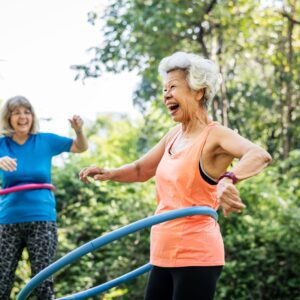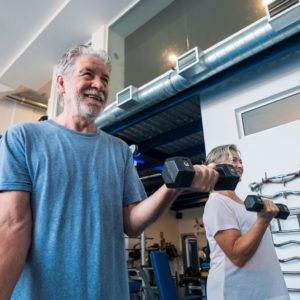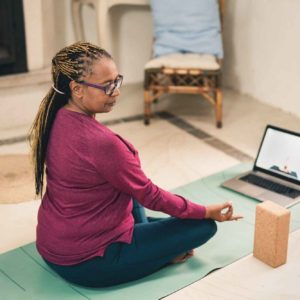Staying active as we age is one of the greatest ways to preserve mobility and maintain vitality. Not only does regular exercise offer incredible benefits to seniors — including enhancing physical strength to boosting mental well-being — but it can also keeps chronic medical conditions at bay.
In this guide, you’ll learn different senior exercises specifically designed for senior health and well-being. However, before engaging in any of these activities it’s important to consult with your primary healthcare provider. Check in with them to make sure you’re following the correct safety precautions and ask about personalized exercise recommendations to ensure you’re exercising in a safe way.
Ready to explore some of the best exercises tailored for adults in their golden years? Let’s go!
What Are the Benefits of Exercise for Seniors?
First, let’s take a moment to recognize the benefits of daily movement in older adults. Engaging in regular physical activity offers a tangible way to enhance your overall quality of life. Whether you’re an avid traveler in retirement or you simply love enjoying time with the grandkids, staying on top of your physical health can enable you to do the things you love. Here are some of the top benefits daily exercise provides for adults over the age of 60:
- Physical Strength and Mobility: Regular exercise helps maintain muscle strength, flexibility, and joint mobility, which is increasingly important as we age. Strengthening muscles and bones reduces the risk of fractures and falls in seniors. Stretching exercises can be particularly helpful here.
- Cardiovascular Health: Aerobic exercises like walking, swimming, and cycling improve heart health and circulation. Most importantly, cardiovascular workouts help lower the risk of heart disease, stroke, and other cardiovascular conditions that affect older adults.
- Cognitive Function: Exercise supports cognitive function, memory, and mental clarity in seniors. Physical activity releases endorphins, which reduces the risk of depression and encourages a positive outlook on life.
- Chronic Disease Management: Regular exercise can help manage chronic conditions such as diabetes, arthritis, and high blood pressure. These chronic conditions can hurt a senior’s quality of life as they age.
- Social Interaction: Group exercise classes and activities provide opportunities for social interaction and connection. It can help seniors foster a sense of belonging and combat feelings of isolation.
How Can Seniors Build Healthy Exercise Habits?
While there are countless benefits to exercising as you age, the reality is that creating — and sticking with — a daily exercise routine can be challenging for people at all ages. To create a sustainable and enjoyable exercise regimen in retirement, follow these easy-to-implement tips.
1. Set realistic goals.
Begin with clear and achievable goals that align with your fitness level and aspirations. Whether it’s walking a certain distance, performing a specific number of repetitions, or participating in a class consistently, setting realistic goals will keep you motivated and prevent overexertion.
2. Find activities you enjoy.
Finding movement you genuinely enjoy increases the likelihood that you’ll stick with it. Whether it’s dancing, swimming, gardening, or practicing yoga, choose activities that bring you joy, making your fitness journey more fulfilling.
3. Prioritize consistency over intensity.
It’s better to engage in moderate activity regularly rather than occasional intense workouts. Aim for 30 minutes of moderate movement every day.
4. Listen to your body.
Pay attention to how your body responds to exercise. If a movement is too difficult, modify the exercise to your current abilities. If you experience pain, dizziness, or discomfort, stop and rest. Pushing through pain can lead to injuries, so it’s important to know your limits and respect them.
5. Rest and recover.
Allow your body adequate time for recovery between workouts. Rest is essential for muscle repair and overall well-being. Overtraining can lead to burnout and injuries, so remember to strike a balance.
What Are the Best Exercises for Seniors?
Now that you understand the benefits of exercise and how to design a sustainable exercise routine, it’s time to decide what type of exercise you’d like to do. While activities using exercise equipment for seniors can be great, it’s important to find equipment-free activities as well. Let’s explore some of the most beneficial exercises for seniors that can be tailored to your individual fitness levels and preferences:
Yoga
This holistic practice focuses on gentle movements, deep breathing, and mindfulness. It offers a range of benefits for retirees, including improved flexibility, balance, and stress reduction. Yoga postures can be modified to accommodate various mobility levels, making it an excellent choice for those seeking a low-impact, yet effective exercise routine.
Water Activities
Water-based activities — such as swimming, water aerobics, and aqua jogging — are highly recommended for seniors. The buoyancy of water reduces impact on joints while providing resistance for muscle strengthening. Water exercises are particularly advantageous for individuals with joint pain or limited mobility, as the water’s supportive nature enhances range of motion.
Pilates
Pilates focuses on core strength, stability, and flexibility. It involves controlled movements that target the deep muscles of the abdomen and back. Pilates exercises can be adapted to accommodate various fitness levels, making it an effective option for seniors looking to improve posture, alignment, and overall body strength.
Walking, Hiking and Jogging
Walking is one of the simplest yet most effective forms of exercise for seniors. It promotes cardiovascular health, strengthens leg muscles, and aids in weight management. Depending on your fitness level, you can choose between a leisurely stroll, brisk walk, or even light jogging. If you’re looking for a more adventurous option, consider hiking on nature trails to engage both body and mind.
Chair Exercises
Senior chair exercises can be an excellent option for folks with limited mobility or balance concerns. A low impact exercise for seniors is typically performed while seated or while using a sturdy chair for support. Chair exercises encompass a wide range of movements that help maintain muscle tone and flexibility.
Here are a few chair exercises to try out:
- Seated leg lifts
- Seated marches
- Seated twists
- Seated row with a resistance band
*Remember to perform these exercises in a controlled manner and within your comfort zone. If you experience any pain or discomfort, stop the exercise and consult your healthcare provider before continuing.
Are There Any Risks That Come With Exercise for Seniors?
Exercise offers numerous benefits for seniors — but there are safety risks to be aware of. Safety should always be a top priority when engaging in physical activity, especially as we age. Here are some potential risks that seniors may face while exercising and how to exercise safely:
- Overexertion. Older adults may be at risk of overexerting themselves, leading to fatigue, dehydration, or even injury. It’s crucial to start slowly and gradually increase the intensity and duration of your workouts. Listen to your body and give yourself adequate rest between sessions.
- Falling out of balance. Balance may become a concern as we age, increasing the risk of falls during exercise. Engaging in exercises that improve balance, such as yoga or balance-specific routines, can help mitigate this risk. Consider using props or a sturdy chair for support when needed.
- Triggering existing health conditions. Certain medical conditions, such as heart disease, arthritis, or osteoporosis, can affect how you should exercise. Before starting any new exercise program, consult your doctor to ensure that your chosen activities are safe and appropriate for your health status.
No matter your age, exercise remains one of the best ways to preserve your physical health, longevity, and mental clarity. Remember, this journey to better health is not about progress, not perfection. Every step you take toward a healthier lifestyle is a victory, and with consistency and care, you can maintain your vitality and enjoy the golden years to the fullest. Retirement Genius is here to cheer you on every step of the way — and answer any questions you may have about during retirement. So, lace up your sneakers and get ready to start running the marathon of your golden years. Your health and well-being will thank you.










